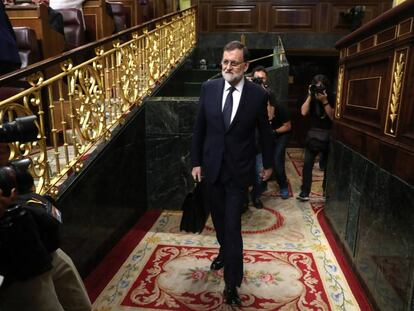Explainer: What happens now the no-confidence motion against Rajoy has succeeded?
These are the legal steps that must be taken following today’s vote in Spanish Congress

The no-confidence motion against Spanish Prime Minister Mariano Rajoy passed on Friday with 180 “yes” votes, four more than the 176 required for an absolute majority.
The government must immediately present Rajoy's resignation, and Socialist leader (PSOE) Pedro Sánchez – who is the replacement candidate – “shall be understood to be appointed” by the parliament as prime minister. King Felipe VI will then officially name him the new head of the Spanish government.
If the motion passes, King Felipe VI will name Pedro Sánchez as the prime minister of Spain
According to lawyers from Congress, this automatic process is due to the “constructive nature of the no-confidence motion.” In other words, Sánchez does not have to be invested in a separate vote because the very motion implies the trust of the Spanish parliament. “The process of a no-confidence motion is actually an alternative to an ordinary investiture. It has the same effect – it establishes the prime minister of the government – but through different channels,” the lawyers explain.
Similarly, Article 179 of Congress Regulations indicates that the speaker of Congress “will make it immediately known to the king and to the prime minister” that the no-confidence motion has been approved. This statement “must accompany the decree naming the new prime minister,” the lawyers add. The decree must be published in the Official State Bulletin (BOE) the day after the no-confidence vote is approved.
English version by Melissa Kitson.
Tu suscripción se está usando en otro dispositivo
¿Quieres añadir otro usuario a tu suscripción?
Si continúas leyendo en este dispositivo, no se podrá leer en el otro.
FlechaTu suscripción se está usando en otro dispositivo y solo puedes acceder a EL PAÍS desde un dispositivo a la vez.
Si quieres compartir tu cuenta, cambia tu suscripción a la modalidad Premium, así podrás añadir otro usuario. Cada uno accederá con su propia cuenta de email, lo que os permitirá personalizar vuestra experiencia en EL PAÍS.
¿Tienes una suscripción de empresa? Accede aquí para contratar más cuentas.
En el caso de no saber quién está usando tu cuenta, te recomendamos cambiar tu contraseña aquí.
Si decides continuar compartiendo tu cuenta, este mensaje se mostrará en tu dispositivo y en el de la otra persona que está usando tu cuenta de forma indefinida, afectando a tu experiencia de lectura. Puedes consultar aquí los términos y condiciones de la suscripción digital.
More information
Archived In
Últimas noticias
Most viewed
- Reinhard Genzel, Nobel laureate in physics: ‘One-minute videos will never give you the truth’
- Oona Chaplin: ‘I told James Cameron that I was living in a treehouse and starting a permaculture project with a friend’
- Pablo Escobar’s hippos: A serious environmental problem, 40 years on
- Charles Dubouloz, mountaineering star, retires at 36 with a farewell tour inspired by Walter Bonatti
- Why we lost the habit of sleeping in two segments and how that changed our sense of time










































